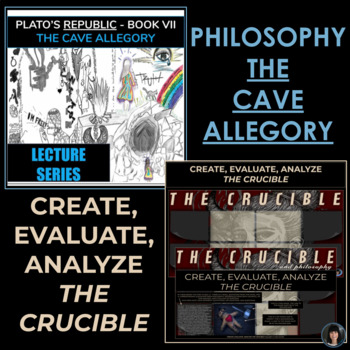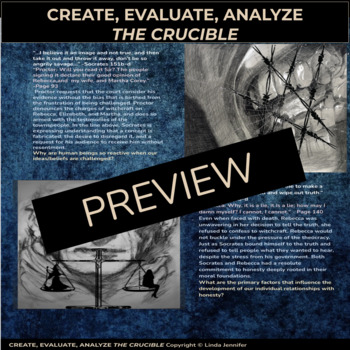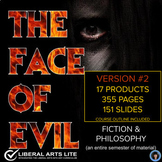PLATO'S CAVE ALLEGORY | THE CRUCIBLE | THE CRUCIBLE ESSAY ALTERNATIVE
- Zip
- Google Apps™
- Internet Activities

Products in this Bundle (2)
Also included in
- PLATO'S CAVE ALLEGORY, APOLOGY, AND THEAETETUS | THE CRUCIBLE | THE CRUCIBLE ESSAY ALTERNATIVE❤️❤️ DISCOUNTED BY 30% ❤️❤️✺ PLATO'S CAVE ALLEGORY | CRITICAL THINKING LECTURETHE ALLEGORY OF THE CAVEThe Cave Allegory is one of the most famous passages of philosophy, and I think all students should study itPrice $14.35Original Price $20.50Save $6.15
- Embark on a captivating intellectual journey with our semester-long curriculum, "The Face of Evil: Fiction and Philosophy." Delve into the enthralling realm of literature and philosophical thought as you explore the intriguing complexities of evil through various fictional works and profound philosoPrice $37.99Original Price $63.88Save $25.89
Description
PLATO'S CAVE ALLEGORY | THE CRUCIBLE | THE CRUCIBLE ESSAY ALTERNATIVE
❤️❤️ DISCOUNTED BY 20% ❤️❤️
✺ PLATO'S CAVE ALLEGORY | CRITICAL THINKING LECTURE
THE ALLEGORY OF THE CAVE
The Cave Allegory is one of the most famous passages of philosophy, and I think all students should study it sometime during their education. It asks its readers to liberate themselves from the conventional bonds that chain them. There are many essays, articles, lecture series, etc. on this fundamental text; there are more nuanced and rigorous academic writings and talks available, but my intention is to provide a 90 minute to two-hour lecture for high school, college, and first or second year university students.
It is a wonderful text to pair with works of fiction; for instance, I teach it alongside The Crucible, The Great Gatsby, Brave New World, 1984, The Giver, Life of Pi, and many others.
INCLUDED IN THIS PRODUCT ARE THE FOLLOWING:
✺ An excerpt, five pages, from Plato’s Republic – Book VII the Cave Allegory. The Republic is one of the Platonic dialogues that I do my VNT assignment on. I also lecture on Plato’s Theaetetus, Apology, Nietzsche’s Thus Spake Zarathustra, and excerpts from Thucydides. I will be creating lectures on these thinkers in the coming months.
✺ 20 pages of teacher notes. Some of the pages of the text are annotated with these notes.
✺ The five pages of text are annotated with some of these notes. I show this to my students on a Whiteboard while I lecture. I do not give these notes out to the students, but rather ask them to write out the parts that are displayed in red. There are some notes that I discuss but do not expect my students to write down.
✺ The VNT example that is on the cover along with the student’s explanation of the VNT.
✺ There are five long answer/essay suggestions.
✺ Eight questions for discussion that are in the presentation and a separate PDF.
✺ A short test with 10 multiple-choice questions and answers.
✺ The five pages of Plato’s Republic, without my notes, that you may distribute to students before the lecture.
☑ CREATE, EVALUATE, ANALYZE | END OF NOVEL PROJECT THE CRUCIBLE
Are you looking for an interesting project to wrap up your book study? I assign this at the end of the semester instead of a final essay. This assignment will test your students’ writing and editing skills, but also reveal their ability to analyze the more nuanced and symbolic passages from THE CRUCIBLE.
This assignment is perfect as an engaging and creative, culminating activity! Students participate in the top three levels of Bloom’s Taxonomy: create, evaluate, and analyze.
This project requires students to think about the imagery and symbolism that are present in the play. Images from a play or movie poster are not allowed. Students are attempting to demonstrate the validity of their interpretation of the text on the slides.
Students choose quotations from the novel that they want to create, evaluate, and analyze. CREATE: they create an image that represents the quotation. EVALUATE and ANALYZE: students explain the quotation and ask a follow-up question that is not easily answerable with a yes or no.
INCLUDED IN THIS PRODUCT ARE THE FOLLOWING:
☑ TWO THE CRUCIBLE TEMPLATES in Google Slides.
☑ FIVE PAGES OF INSTRUCTIONS for teachers.
☑ THREE PAGES OF INSTRUCTIONS for students.
☑ A VIDEO INSTRUCTIONAL GUIDE for students. This video shows how to create an assignment with the novel Life of Pi. I use this video to review the assignment even if I am using another novel as the ideas are the same.
☑ NINE GOOGLE SLIDES to share with your students. THIS IS THE FILE STUDENTS WORK IN. I ask my students to do three slides for 12 images and 12 text boxes without philosophy and eight images and eight text boxes with philosophy. So the template is copied and pasted twice so you can decide how many slides to send to your students. See the next page for more details. The instructions are editable. Remove any slides you do not wish to use before you assign the project to your students.
☑ AN EXAMPLE OF A TEXT BOX AND IMAGE WITHOUT PHILOSOPHY. (LIFE OF PI)
☑ AN EXAMPLE OF A TEXT BOX AND IMAGE WITH PHILOSOPHY. (THE CRUCIBLE)
☑ EIGHT STUDENT EXAMPLE on THE CRUCIBLE.
☑ One page with information about my products.
☑ There is a link that you share with your students to use interactively through Classroom™ or other online programs.
☑ Information on Google Slides™ for teachers and students.
Related Products:
• HIGHER ORDER THINKING AND VNT (PLATO'S THEAETETUS) PERFECT PAIRING BUNDLE
• HIGHER ORDER THINKING, VNT, AND VNT (PLATO'S THEAETETUS) BUNDLE
• Higher Order Thinking Skills HOTS #3 (THE THEAETETUS) WHAT IS KNOWLEDGE?
• VISUAL NOTETAKING LECTURE SERIES (PLATO'S THEAETETUS)
• CRITICAL THINKING ACTIVITY: DAILY DILEMMA ONE SHEET (#3) (Ethics, Justice)
• CRITICAL THINKING: SOCRATES AND THE INSANITY DEFENSE
• PROJECTS: DAILY DILEMMA ONE SHEET (#2) critical thinking, debate
How to get TPT credit to use on future purchases:
• Please go to your My Purchases page (you may need to login). Beside each purchase, you'll see a Provide Feedback button. Simply click it and you will be taken to a page where you can give a quick rating and leave a short comment for the product. I value your feedback greatly as it helps me determine which products are most valuable for your classroom so I can create more for you.
❤️ Click HERE to become a follower. You will now receive customized email updates about this store.
Copyright © jellycat-in-the-snow productions
All rights reserved by author Permission to copy for single classroom use only Electronic distribution limited to single classroom use only
Please remember that any of the products that you download from my store are my copyrighted property and licensed only for you to share with your direct students. If another teacher wants to use these same products, they will need to purchase them directly from my TpT store, or you may purchase an additional license for them. None of my products may be shared online. Posting of my copyrighted materials may happen only in a password-protected environment, such as Google Classroom, and accessed only by your students. Posting on public websites (WordPress, Blogger, Facebook Groups, etc.) is strictly prohibited.







